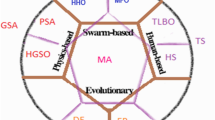Abstract
Optimization of an engineering system or component makes a series of changes in the initial random solution(s) iteratively to form the final optimal shape. When multiple conflicting objectives are considered, recent studies on innovization revealed the fact that the set of Pareto-optimal solutions portray certain common design principles. In this paper, we consider a 14-variable bi-objective design optimization of a MEMS device and identify a number of such common design principles through a recently proposed automated innovization procedure. Although these design principles are found to exist among near-Pareto-optimal solutions, the main crux of this paper lies in a demonstration of temporal evolution of these principles during the course of optimization. The results reveal that certain important design principles start to evolve early on, whereas some detailed design principles get constructed later during optimization. Interestingly, there exists a simile between evolution of design principles with that of human evolution. Such information about the hierarchy of key design principles should enable designers to have a deeper understanding of their problems.
Access this chapter
Tax calculation will be finalised at checkout
Purchases are for personal use only
Preview
Unable to display preview. Download preview PDF.
Similar content being viewed by others
References
Bandaru, S., Deb, K.: Automated Innovization for Simultaneous Discovery of Multiple Rules in Bi-objective Problems. In: Takahashi, R.H.C., Deb, K., Wanner, E.F., Greco, S. (eds.) EMO 2011. LNCS, vol. 6576, pp. 1–15. Springer, Heidelberg (2011)
Bandaru, S., Deb, K.: Towards automating the discovery of certain innovative design principles through a clustering-based optimization technique. Engineering Optimization 43(9), 911–941 (2011)
Chankong, V., Haimes, Y.Y.: Multiobjective Decision Making Theory and Methodology. North-Holland, New York (1983)
Deb, K.: Multi-objective optimization using evolutionary algorithms. Wiley, Chichester (2001)
Deb, K., Agrawal, R.: Simulated binary crossover for continuous search space. Complex Systems 9(2), 115–148 (1995)
Deb, K., Pratap, A., Agarwal, S., Meyarivan, T.: A fast and elitist multi-objective genetic algorithm: NSGA-II. IEEE Transactions on Evolutionary Computation 6(2), 182–197 (2002)
Deb, K., Srinivasan, A.: Innovization: Innovating design principles through optimization. In: Proceedings of the 8th Annual Conference on Genetic and Evolutionary Computation, GECCO 2006, pp. 1629–1636. ACM, New York (2006)
Fedder, G., Mukherjee, T.: Physical design for surface-micromachined MEMS. In: Proceedings of the Fifth ACM SIGDA Physical Design Workshop, Virginia, USA (April 1996)
Haeckel, E.: The evolution of man, vol. 1. Kessinger Publishing (1879)
Newman, M.: Power laws, pareto distributions and zipf’s law. Contemporary Physics 46(5), 323–351 (2005)
Reklaitis, G., Ravindran, A., Ragsdell, K.: Engineering optimization: Methods and applications. Wiley, New York (1983)
Tutum, C.C., Fan, Z.: Multi-criteria layout synthesis of mems devices using memetic computing. In: IEEE Congress on Evolutionary Computation, pp. 902–908 (2011)
Author information
Authors and Affiliations
Editor information
Editors and Affiliations
Rights and permissions
Copyright information
© 2012 Springer-Verlag Berlin Heidelberg
About this paper
Cite this paper
Deb, K., Bandaru, S., Celal Tutum, C. (2012). Temporal Evolution of Design Principles in Engineering Systems: Analogies with Human Evolution. In: Coello, C.A.C., Cutello, V., Deb, K., Forrest, S., Nicosia, G., Pavone, M. (eds) Parallel Problem Solving from Nature - PPSN XII. PPSN 2012. Lecture Notes in Computer Science, vol 7492. Springer, Berlin, Heidelberg. https://doi.org/10.1007/978-3-642-32964-7_1
Download citation
DOI: https://doi.org/10.1007/978-3-642-32964-7_1
Publisher Name: Springer, Berlin, Heidelberg
Print ISBN: 978-3-642-32963-0
Online ISBN: 978-3-642-32964-7
eBook Packages: Computer ScienceComputer Science (R0)




